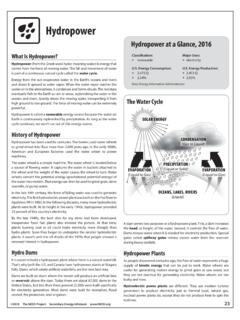Transcription of Electric Vehicle Battery Thermal Issues and Thermal ...
1 Electric Vehicle Battery Thermal Issues and Thermal Management Techniques John P. Rugh, NREL Ahmad Pesaran, NREL Kandler Smith, NREL NREL/PR-5400-52818 Presented at the SAE 2011 Alternative Refrigerant and System Efficiency Symposium September 27-29, 2011 Scottsdale, Arizona USA 2 Outline Introduction Importance of Battery temperature Review of Electric drive Vehicle (EDV) Battery Thermal management options Techniques to improve Battery life Standby Thermal management Preconditioning Tradeoff with Thermal comfort Summary 3 Battery is The Critical Technology for EDVs Enables hybridization and electrification Provides power to motor for acceleration Provides energy for Electric range and other auxiliaries Helps downsizing or eliminating the engine Enables regenerative braking Adds cost, weight, and volume Could decrease reliability and durability Decreased performance with aging Raises safety concerns 3 Lithium-ion Battery cells, module, and Battery pack for the Mitsubishi iMiEV (Courtesy of Mitsubishi)
2 4 As The Size of The Engine Is Reduced, The Battery Size Increases Size of Electric Motor (and associated energy storage system) Size of Fueled Engine conventional internal combustion engine (ICE) vehicles Electric vehicles (EVs) ( Battery or fuel cell) Micro hybrids (start/stop) Mild hybrids (start/stop + kinetic energy recovery) Full hybrids (medium hybrid capabilities + Electric launch) Plug-in hybrids (full hybrid capabilities + Electric range) Medium hybrids (mild hybrid + engine assist ) Axes not to scale 5 Battery Requirements for Different EDVs Vehicle Power (kW) Energy (kW/h) Cycles Micro and Mild Hybrid Electric Vehicles (HEVs) Very high power Low energy Many (400K) shallow charge/discharge cycles ( 5% change) Medium and Full HEVs High power Moderate energy Many (300K) shallow charge/discharge cycles ( 10% change) Plug-in HEVs (PHEVs) High power High energy Many (200K) shallow charge/discharge cycles ( 5% change) Many (3-5K)deep discharge cycles (50% change) Battery EVs Moderate power Very high energy Many (3-5K) deep discharges (70% change) Calendar life of 10+ years Safety: the same as ICE vehicles 6 Lithium ion technology comes close to meeting most of the required technical and cost targets in the next 10 years.
3 Energy and Power by Battery Type 7 Battery Cycle Life Depends on State-of-Charge Swing 4,000 50% 70% PHEV Battery likely to deep-cycle each day driven: 15 yrs equates to 4,000 5,000 deep cycles Source: Christian Rosenkranz (Johnson Controls) at EVS 20, Long Beach, CA, November 15-19, 2003 Potential Potential Potential Potential 8 Outline Introduction Importance of Battery temperature Review of EDV Battery Thermal management options Techniques to improve Battery life Standby Thermal management Preconditioning Tradeoff with Thermal comfort Summary 9 Phoenix44oC max, 24oC avg0oCHouston39oC max, 20oC avgMinneapolis37oC max, 8oC avg10oC20oC30oCImpact of Geography and Temperature on Battery Life Li-ion technology must be sized with significant excess power to last 15 years in hot climates 10 Li-Ion Battery Resistance Increases with Decreasing Temperature Power decreases with decrease in temperature Impacts power capability of motor and Vehicle acceleration 11 Useful energy from the Battery decreases with decrease in temperature Impacts driving range and performance of Vehicle Li-Ion Battery Capacity Decreases with Decreasing Temperature 12 Battery Temperature is Important Temperature affects Battery .
4 Operation of the electrochemical system Round trip efficiency Charge acceptance Power and energy availability Safety and reliability Life and life-cycle cost Battery temperature affects Vehicle performance, reliability, safety, and life-cycle cost 13 Temperature Impacts Battery Sizing & Life and Thus Cost PowerLimits15 C35 CdischargechargeRatedPowerTDegradationSl uggishElectrochemistryPowerLimits15 C35 CdischargechargeRatedPowerTDegradationSl uggishElectrochemistryDictates power capability Also limits the Electric driving range Power and energy fade rates determine the original Battery size Power limited to minimize T increase and degradation Kandler Smith, NREL Milestone Report, 2008 Desired Operating Temperature 14 Battery High-Temperature Summary Primary considerations Life Safety Non-uniform aging due to Thermal gradients Cooling typically required In hot environments (could be 24 hr) During moderate to large current demands during drive During fast charging Photo Credit: John Rugh, NREL 15 Battery Low-Temperature Summary Primary considerations Performance Damage due to charging too fast Heating typically required In cold environments during charging and discharging Photo Credit.
5 Mike Simpson, NREL 16 Outline Introduction Importance of Battery temperature Review of EDV Battery Thermal management options Techniques to improve Battery life Standby Thermal management Preconditioning Tradeoff with Thermal comfort Summary 17 Regulate pack to operate in the desired temperature range for optimum performance/life 15oC 35oC Reduce uneven temperature distribution Less than 3oC 4oC Eliminate potential hazards related to uncontrolled temperatures Thermal runaway Battery Pack Thermal Management Is Needed 18 Battery Thermal Management System Requirements Compact Lightweight Easily packaged Reliable Serviceable Low-cost Low parasitic power Optimum
6 Temperature range Small temperature variation 19 Battery Pack Outside Air Exhaust Fan Battery Pack Cabin Air Exhaust Fan Outside Air Return Vehicle heater and evaporator cores Battery Pack Exhaust Fan Outside Air Return Auxiliary or Vehicle heater and evaporator cores Outside Air Ventilation Cabin Air Ventilation Heating/cooling of Air to Battery Outside or Cabin Air Prius & Insight Thermal Control Using Air i-MiEV (fast charge) 20 Battery Heating and Cooling Using Air Pro Con All waste heat eventually has to go to air Low heat transport capacity Separate cooling loop not required More temperature variation in pack Low mass of air and distribution system Connected to cabin temperature control No leakage concern Potential of venting Battery gas into cabin No electrical short due to fluid concern High blower power Simple design Blower noise Lower cost Easier maintenance 21 Thermal Control Using Liquid Liquid Pump Liquid/air heat exchanger Fan Outside Air Exhaust Battery Pack Pump Liquid/air heat exchanger Fan Outside air Exhaust Battery Pack Liquid direct -contact or jacketed Refrigerant Liquid Pump Liquid/liquid
7 Heat exchanger or Electric heater Pump Vehicle engine coolant Return Battery Pack A/C heat exchanger Liquid direct-contact or jacketed Ambient cooling Active dedicated cooling/heating Volt, Tesla 22 Battery Heating and Cooling Using Liquid Pro Con Pack temperature is more uniform - thermally stable Additional components Good heat transport capacity Weight Better Thermal control Liquid conductivity electrical isolation Lower pumping power Leakage potential Lower volume, compact design Higher maintenance Higher viscosity at cold temperatures Higher cost 23 Outline Introduction Importance of Battery temperature Review of EDV Battery Thermal management options Techniques to improve Battery life Standby Thermal management Preconditioning Tradeoff with Thermal comfort Summary 24 Standby Thermal Cooling in Hot Climates Battery life can greatly benefit from cooling the Battery during standby, , while Vehicle is plugged in to the grid Slower Battery degradation rate enables smaller, lower cost Battery NREL study investigated Insulation Insulation and air cooling Insulation and small vapor compression system (VC)
8 Insulation, small VC system, and phase change material (PCM) 25 Phoenix Houston Minneapolis Phoenix Houston Minneapolis Saft HP-12LC Cell (Belt/INL, ECS Mtg. 2008) low fade rate, high cost DOE/TLVT Cell (Christopersen/INL, Battaglia/LBL, 2007 Merit Review) moderate fade rate, lower cost 5%-10% less power fade with Ins. + VC 9%-22% less power fade with Ins. + VC Lower cost cell preferred, provided it can meet life. Next slide compares costs of DOE/TLVT Battery sized for 15 years in Phoenix, w/ and w/o insulation + VC system. Battery Life for Various Standby Systems can differ widely depending on cell chemistry, materials, and manufacturer 26 Savings from Downsized Battery Expected to Significantly Outweigh Cost of Added Components DOE/TLVT cell sized for 15 years.
9 In Phoenix, AZ, charged nightly ($360) ($320) ($250) PHEV10 kWh kW VC Fan Insulation kWh kW VC Fan Insulation kWh kW VC Fan Insulation PHEV20 PHEV40 Total Savings ($) Total savings assuming components represent additional cost PHEV10 PHEV20 PHEV40 27 Standby Thermal Management Passive Techniques to Reduce Battery Temperatures Installed metalized solar reflective film on the glazings of a Toyota Prius in Phoenix Cabin air temperature reduced ~6oC Before: Battery daily max temp above ambient After: Battery daily max temp 2oC below ambient Photo Credit: John Rugh, NREL 28 Thermal Preconditioning Issues : For conventional Vehicle and HEV platforms, A/C use leads to increased fuel consumption For PHEV and EV platforms, climate control energy is supplied by the traction Battery Charge depletion (CD) range reduction Batteries degrade rapidly at high temperatures and benefit from active cooling Batteries suffer from reduced power and energy at cold temperatures.
10 Their performance can be improved by preheating Battery wear and life impacts Potential Solution: Use grid power to thermally precondition cabin and Battery Save valuable onboard stored energy for propulsion 29 Preconditioning, Driving & Charging Patterns Affect Battery Temperature and Duty-Cycle 24-hour profiles created to estimate impact of preconditioning on Battery life 6 am 10 am 3 pm 8 pm 1 am 6 am Rest 20 minute preconditioning 8:00 am: km trip Rest 20 minute preconditioning 5:00 pm: km trip 10:00 pm: Charge at kW Rest 6 am 10 am 3 pm 8 pm 1 am 6 am PHEV40s, hwy cycle, 95 F (35 C) ambient. Battery heat generation rates and SOC extracted from PSAT Vehicle simulations of charge-depleting and charge-sustaining operation.












